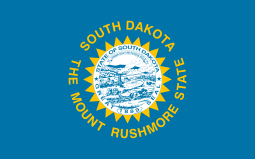Richard F. Kneip
| Richard F. Kneip | |
|---|---|
| 7th United States Ambassador to the Republic of Singapore | |
|
In office May 26, 1978 – September 25, 1980 | |
| President | Jimmy Carter |
| Preceded by | John H. Holdridge |
| Succeeded by | Harry E. T. Thayer |
| 25th Governor of South Dakota | |
|
In office January 4, 1971 – July 24, 1978 | |
| Lieutenant |
William Dougherty Harvey L. Wollman |
| Preceded by | Frank Farrar |
| Succeeded by | Harvey L. Wollman |
| Personal details | |
| Born |
January 7, 1933 Tyler, Minnesota |
| Died |
March 9, 1987 (aged 54) Sioux Falls, South Dakota |
| Political party | Democratic |
| Spouse(s) | Nancy Pankey |
| Children | 8 |
| Profession | businessman |
| Religion | Roman Catholic |
| Military service | |
| Service/branch | United States Air Force |
| Years of service | 1951-1955 |
Richard Francis "Dick" Kneip (January 7, 1933 – March 9, 1987) was the 25th Governor of South Dakota from 1971 until 1978. He was a member of the Democratic Party and the first Catholic Governor of South Dakota.
Biography
Kneip was born on January 7, 1933, in Tyler, Minnesota, to Berniece and Frank Kneip, who lived in Elkton, South Dakota. He was of Luxembourgish ancestry.[1] He attended South Dakota State University and St. John’s University. He served in the U.S. Air Force and then owned a wholesale dairy equipment distributorship in Salem, South Dakota. He married Nancy Lou Pankey.[2]
Career
He served in the South Dakota Legislature as a State Senator from 1965 to 1971.[3]
When Richard F. Kneip was elected governor of South Dakota in 1970, defeating the Republican incumbent Frank Farrar, he was only the fourth governor elected from the Democratic Party since statehood. Known to the state's voters as "Dick", Kneip gained popularity through his "people to people" campaigns. Kneip memorably launched his 1970 campaign for governor with radio ads asking "What is a Kneip?".
At the time he first took office, Dick Kneip became the youngest governor the state had elected. Kneip and his wife, Nancy, moved into the governor's mansion, along with their eight sons.
Kneip's first term was noted for major reform efforts. He successfully overhauled the organization of state government by creating a cabinet system. Kneip was re-elected in 1972, and became the last governor of South Dakota to serve a two-year term. He twice served two-year terms and then was elected to a final four-year term in 1974. This made Kneip the first governor to be elected three times.
At the start of Kneip's second term in 1973, the state gained national attention because of a standoff between Native American activists and government agents at Wounded Knee.
Kneip appeared on the November 19, 1977 episode of Saturday Night Live as one of the five finalists in the show's "Anyone Can Host" contest, which was won by Miskel Spillman.
Kneip resigned as governor on July 24, 1978, a few months before the expiration of his third term. He had been selected by President Jimmy Carter to become the United States ambassador to Singapore.
Kneip sought to return to the governor's mansion in 1986, but he narrowly lost his party's nomination in the state Democratic Party primary to nominee Lars Herseth that June.[4]
Death and legacy
Although he had pondered yet another attempt at returning to public life, Kneip was diagnosed with cancer in early 1987. He died in Sioux Falls, South Dakota, on March 9, 1987 at the age of 54.
In 1997, U.S. Highway 14 from Brookings to Elkton, was officially designated as the Richard Kneip Memorial Highway.[5]
References
- ↑ Biographical Directory of the South Dakota Legislature, 1889-1989 (1989), p. 608.
- ↑ "Richard F. Kneip". National Governors Association. Retrieved 2 September 2012.
- ↑ "Richard Kneip from Elkton, SD". South Dakota Hall of Fame. Retrieved 2010-03-31.
- ↑ Kundert, Alice (June 3, 1968). "Official Election Returns and Registration Figures For South Dakota Primary Election" (PDF). Retrieved 2007-11-14.
- ↑ Soyer, Jim. "Part of Highway 14 Named After Former Governor Dick Kneip". Archived from the original on 2007-09-29. Retrieved 2007-11-14.
External links
- Richard Kneip's burial record on Findagrave.com
- Richard Kneip's listing in the South Dakota Hall of Fame
- National Governors Association
| Political offices | ||
|---|---|---|
| Preceded by Frank Farrar |
Governor of South Dakota 1971–1978 |
Succeeded by Harvey L. Wollman |
